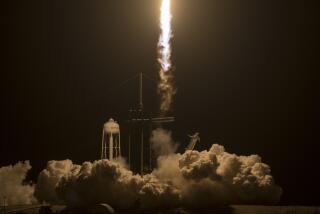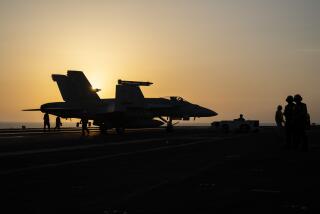3 Die in Fire Aboard Soviet Nuclear Sub
WASHINGTON — A Soviet missile-firing nuclear submarine in the Atlantic sustained an onboard fire that killed three crewmen, and the Soviet government promptly assured the United States that there was no danger of a nuclear explosion or contamination, the White House disclosed Saturday.
Hours after the announcement in Washington and the release of a similar statement in Moscow, a U.S. Navy P-3 Orion anti-submarine patrol plane spotted the vessel on the surface of the ocean about 480 nautical miles northeast of Bermuda and 1,080 miles east of Cape Hatteras, N.C.
Pentagon sources said there was no evidence of continuing fire, and at least four Soviet merchant ships were in the immediate area. Although President Reagan, spending the weekend at Camp David, immediately offered U.S. assistance, there was no request for help from the Soviets.
‘There Is No Danger’
In the Soviet Union, the news agency Tass’ brief, official announcement of the mishap said: “After analyzing the situation, an expert commission in Moscow reached the conclusion that there is no danger of any unauthorized action (accidental launching) of weapons, a nuclear explosion or radioactive contamination of the environment.”
Tass said that “the submarine’s crew and other Soviet ships, which sailed up to help, are dealing with the consequences of the fire.”
“There are casualties aboard the submarine. Three persons died,” it added.
The announcement of the accident--about 24 hours after it occurred--and the accompanying assurances were taken by Administration officials in Washington as evidence that the Soviet government was anxious that the incident not be allowed to complicate planning for the meeting between Reagan and Soviet leader Mikhail S. Gorbachev next weekend in Iceland.
Defense Department spokesman Robert Sims, traveling with Defense Secretary Caspar W. Weinberger between Washington and Anchorage, Alaska, on the first leg of a round-the-world survey trip, told reporters that defense officials first learned of the accident about 5 a. m. (EDT) Saturday, about four hours before Gorbachev informed Reagan through diplomatic channels.
Yankee-Class Submarine
At the Pengaton, Col. Marvin Brayman identified the stricken vessel as a Yankee-class submarine. The Soviet Yankee I class can carry 16 SSN-6 missiles, each with the capability of delivering two nuclear warheads over a range of 1,800 miles. Missiles aboard the more advanced Yankee II subs have a 2,400-mile range.
Weinberger told reporters he did not know if the fire was associated with the vessel’s twin-reactor power plant, but he said he did not think that it had anything to do with the submarine’s weapons compartment. The Tass news agency account said only that the fire broke out in “a compartment” of the submarine.
Weinberger and other Defense Department officials said it is assumed that the submarine was on routine patrol at the time of the accident.
Reporting any information at all on a military tragedy is unusual for the Soviet Union, which never in the past has commented on Western reports of Soviet submarine accidents.
Previous Sub Accidents
In August, 1983, for example, U.S. intelligence sources said that a Soviet nuclear submarine sank in the North Pacific with the death of 90 or more crew members.
Three years earlier, Japanese officials said that at least nine sailors were killed when fire broke out aboard a Soviet nuclear submarine off southern Japan. Moscow never acknowledged any such accident.
Since Gorbachev took over in March, 1985, however, he has proclaimed a policy of glasnost , or openness, which has brought greater disclosure of the details of major accidents.
A little more than a month ago, for example, Soviet officials provided detailed information within 48 hours after a cruise ship, the Admiral Nakhimov, was rammed by a freighter and nearly 400 of its passengers were killed.
Speculation on Candor
U.S. officials speculated that at least two factors, in addition to the upcoming meeting between the U.S. and Soviet leaders, stimulated Saturday’s unusual candor: the certainty that the submarine would be quickly spotted and identified on the surface and the widespread criticism of the Soviets’ handling of the Chernobyl nuclear disaster in the first days after the reactor fire.
“I think it is interesting that they reported it as quickly as they did,” Weinberger said. “I think we probably all remember Chernobyl, and they didn’t want to let a long time elapse.” Some of the 24-hour delay, he said, was obviously attributable to the fact that the submarine crew was occupied for some time trying to contain or control the fire.
Despite Weinberger’s strong doubts that the fire was in the weapons compartment, other knowledgeable sources speculated that the blaze might have indeed taken place in the weapons bay and that the Soviets moved to warn the United States’ before it detected any release of radiation.
Storage Batteries a Problem
Other submarine experts suggested that the accident might have originated with storage batteries used to provide emergency power in the case of a shutdown of the nuclear power plant. Over the years, such batteries haved been known to explode.
Although the accident occurred nearly 24 hours before the public disclosure by the Soviet government, White House spokesman Roman Popadiuk commended the Kremlin for the “quick notification of this accident.”
Officials said that both the President and White House national security adviser John M. Poindexter were keeping abreast of the situation through the day.
Pentagon sources attached no special significance to the submarine’s being in the area, saying that the Yankee class vessels routinely patrol off the East Coast of the United States, their missiles capable of reaching strategic targets east of the Mississippi River within minutes of launch.
A Real Embarrassment
Nevertheless, said Hudson Institute submarine expert Norman Friedman, the incident amounted to a real embarrassment since it compromised an operational patrol by the submarine.
It was not the first time that a nuclear-powered Soviet sub has suffered a fire while running submerged. Several years ago, an Echo-class attack submarine was forced to the surface by an onboard fire.
In another much-publicized episode off the Eastern Seaboard, a Soviet Victor-class attack sub was forced to surface after its propeller was disabled when it became entangled with a cable being used by a U.S. submarine-hunting vessel to tow a buoy.
Although the Yankee-class submarines patrol on the fringes of U.S. territory in both the Atlantic and the Pacific, the vessels, powered by twin nuclear reactors, are far from the Soviets’ most modern missile-launching submarines.
They joined the Soviet fleet between 1967 and 1974.
The backbone of the Soviet missile-firing submarine fleet is the giant Typhoon class introduced four years ago with tubes for 20 nuclear missiles with a range of 5,000 miles.
Times staff writers William J. Eaton, in Moscow, and James Gerstenzang, traveling with Weinberger, contributed to this story.
More to Read
Sign up for Essential California
The most important California stories and recommendations in your inbox every morning.
You may occasionally receive promotional content from the Los Angeles Times.










